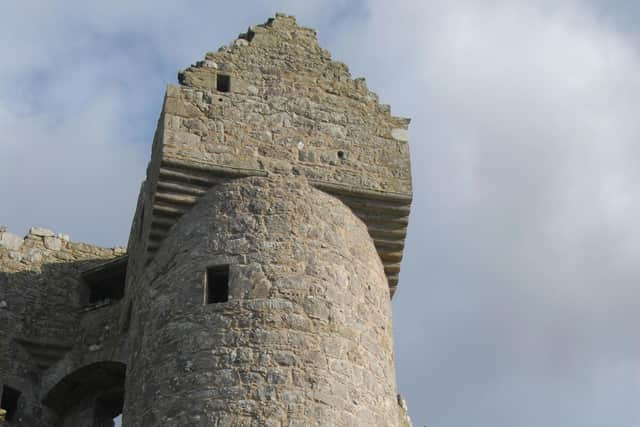Archbishop Malcolm Hamilton’s influence lives on 400 years after his consecration


The castle survives almost to full height, with two circular towers at its entrance.
This imposing structure stood in one corner of a walled bawn, which was built to enclose and protect the castle, and was equipped with defensive rounded flanker towers, positioned in two corners of the bawn.
Advertisement
Hide AdAdvertisement
Hide AdAs Rowan explains: ‘Built of hard local limestone with sandstone dressing, the outer walls are well preserved and give a good idea of what the castle must have looked like when functioning as an important house, though with such a Scottish-looking building, it is hard to imagine the thatch that originally covered its roofs.’
The castle fell briefly into Irish hands in 1641, and was held by Gustavus Hamilton, his grandson and the celebrated governor of Enniskillen in 1688.
A fire in the mid-18th century led to the castle’s abandonment.
Monea Castle was built circa 1618 by Malcolm Hamilton, a Scottish-born Church of Ireland cleric.
Advertisement
Hide AdAdvertisement
Hide AdHe was the son of Archibald Hamilton and either Maria Barkley of Ladeland or Anna Kennedy of Stamhasset Cassily. His father may have been one of the Hamiltons of Raplock, Lanarkshire.
Malcolm matriculated at St Andrews University in 1596 and graduated MA in 1600. He was one of the many Hamiltons to have settled in Ulster at the time of the Plantation.
In 1612 he became chancellor of the diocese of Down and a decade later he became prebend of Devenish (the ecclesiastical name for Monea) in the diocese of Clogher.
On May 23 1623 Hamilton was appointed archbishop of Cashel, being consecrated on June 29 of that year.
Advertisement
Hide AdAdvertisement
Hide AdHe was allowed to retain his previous benefices because the resources of the see had been seriously depleted because of the alienations of his predecessor, Miler Magrath.
His appointment as archbishop of Cashel was evidence of the high regard in which he was held. So too was his appointment as a member of the Irish Privy Council in 1624.
By the mid-1620s Hamilton was a prominent opponent of Charles I’s policy of de facto toleration of Roman Catholicism.
In April 1627 he preached at Christ Church against toleration. In 1628 he presented a petition from the Munster clergy to the king, argued that it was his duty to oppose heresy even in contravention of his king's wishes.
Advertisement
Hide AdAdvertisement
Hide AdThis strongly suggests Presbyterian or Puritan leanings. After all, this was the Prescopalian era, admittedly drawing to a close, when Presbyterian-inclined clergy were able to serve in the Church of Ireland.
Hamilton died of fever April 25 1629 in his house at Camus, near Cashel, and was buried in Cashel cathedral on May 2. An inscription was erected in his memory there, but this was defaced by the Jacobites.
Two of Malcolm’s sons served with distinction in the Swedish army. A huge proportion of the adult male population of Scotland served in the armies of continental Europe during the 17th century, especially during the Thirty Years’ War.
Hugh, one of the sons of Malcolm’s first marriage, was created baron of Deserf in Sweden. Ludovic, a son of Malcolm’s second marriage, was also elevated to baronial rank.
Advertisement
Hide AdAdvertisement
Hide AdGustavus Hamilton (Baron Gustaf or Gustav Ludvigsson Hamilton in Swedish), the governor of Enniskillen in 1688, was the elder of the two sons of Ludovic Hamilton and his Swedish wife. (One of the great problems of 17th-century Ulster history is the sheer number of Hamiltons which you encounter. The governor of Enniskillen is often confused or conflated with his contemporary of the same name who was governor of Coleraine in 1689.)
He played a significant role in organising the successful Williamite defence of Enniskillen and the Erne valley, which found eloquent expression in his defiant words: ‘We do stand upon our guard and do resolve by the blessing of God to meet our danger than expect it.’
Hamilton realised that was of crucial importance that Jacobite forces should be prevented from getting near the town, for if they did so, they would readily appreciate the town’s vulnerability.
Hence the strategy of aggressive defence which found eloquent expression in Gustavus Hamilton’s defiant words: ‘We do stand upon our guard and do resolve by the blessing of God to meet our danger than expect it.’
Advertisement
Hide AdAdvertisement
Hide AdHamilton’s strategy was brilliantly executed by Thomas Lloyd of Co Roscommon (nicknamed ‘little Cromwell’ by his men), whose military acumen overshadowed that of Hamilton.
Lloyd mounted a series of enterprising and stunningly successful raids, reminiscent of those of the Border reivers on the Anglo-Scottish border, against the Jacobite forces. By contrast Hamilton's only foray, an overly ambitious and unrealistic bid in early June to relieve Derry, was a failure.
A third brother of Hugo and Ludovic’s, Captain John Hamilton, had two sons, Malcolm (1635-1699) and Hugo (1655-1724) who arrived in Sweden in 1654 and 1680 respectively, and were created barons in 1689 under the name Hamilton af Hageby.
The former became a major-general and governor of Northern Sweden. The latter was appointed a lieutenant-general by Charles XII and in 1715.
Advertisement
Hide AdAdvertisement
Hide AdBecause of his Scottish ancestry, ironically he was made commander of a planned expedition to aid the Jacobites. Malcolm Hamilton’s son, Gustaf David (1699-1788) became a field marshal, and was created a count.
Hamiltons continue to play prominent roles in Swedish life right up into our own time.
Gustaf David Gilbert John William Hamilton, (1869-1947) was a highly decorated soldier, holding Swedish, Finnish and German military honours.
Björn Axel Åke Malcolm Hamilton (born 1945) is a Swedish count, an engineer and a politician.
Carl Peter Bastiat Hamilton (born in 1946) is a Swedish count, economist and politician.
All of which takes us a long way from Monea.